牛津英语1B课程纲要安晓鸽
- 格式:doc
- 大小:17.84 KB
- 文档页数:3
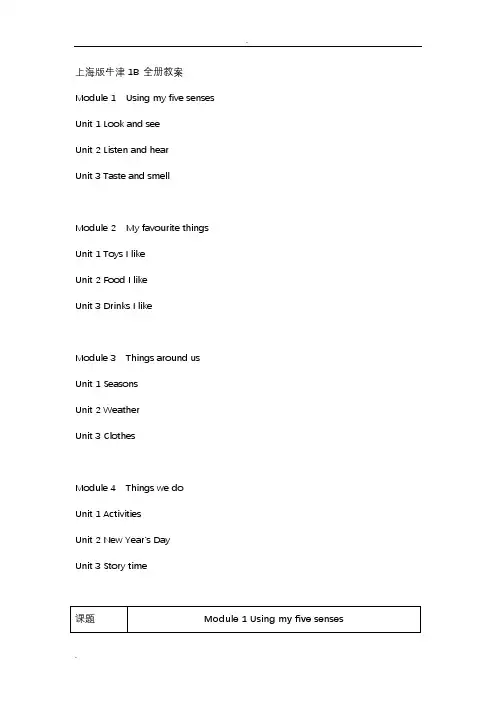
上海版牛津1B 全册教案Module 1 Using my five sensesUnit 1 Look and seeUnit 2 Listen and hearUnit 3 Taste and smellModule 2 My favourite thingsUnit 1 Toys I likeUnit 2 Food I likeUnit 3 Drinks I likeModule 3 Things around usUnit 1 SeasonsUnit 2 WeatherUnit 3 ClothesModule 4 Things we doUnit 1 ActivitiesUnit 2 New Year's DayUnit 3 Story time课题Module 1 Using my five sensesUnit 1 Look and seeLook and learn教学目标知识与技能:ing the new words in the context eg. frog, rabbit, bee, bird2.Asking wh-questions to find out what people seeeg. What do you see?ing formulaic expressions to indicate what peoplesee eg. I see…过程与方法:ing modeled phrases to communicatewith other studentsing modeled phrases to begin and maintain aninteraction by providing information in responseto factual questions教学重点和难点1.Identify the key words in an utterance byhearing the pronunciationeg. frog, rabbit, bee, bird2.Understand the meaning of wh-questionseg. What do you see?3.Understand the key patterneg. I am a ….教学媒体Pictures, masks, Cassette 1A, Cassette playerListening to the recording of the text.课前学生准备教学流程Pre-task preparation1.Warmerlisten to the song:<Good morning>Greetings2.Greetings.Good morning.Good afternoon.……T: Ask pupils to answer the teacher’s questions.While-task procedure1.IntroductionI see …Show a picture of a park to the students. Ask them what theysee.To elicit the structure:I see …(bird bee rabbit frog)2.Teach some new words.bird bee rabbit frog3.I’m a….Mime the small animals and let students guess what theanimals are.4.bird…Ask the students to say and mime the actions of the animals.One, two, three…I am a bee.…Teach the rhyme on Book P 2Post-task activity1.SubstitutionI am……Ask pupils to review the new sentences.Eg.A: One two three …B: I am a bee.A: Four , five.B: I am…板书设计frog rabbit bee birdI am a…教学效果的反馈课题Module 1 Using my five sensesUnit 1 Look and seeLook and say教学目标Language Focus:Using formulaic expressions to learn the phrases;Language Skill:Listening: Understand the meanings of wh-questionsSpeaking: Ask wh-questions to find out what people seeUse formulaic expressions to indicate what people see.教学重点和难点Understand the meaning of wh-questions eg. What do you see?eg. I see a ….教学媒体Pictures, masks, Cassette 1A, Cassette player课前学生准备Listening to the recording of the text.教学流程Pre-task preparation1.Show the words of the animals.bird rabbit bee….2.Ask; What do you see?I see….Are you a rabbit?Yes? No, I’m a …3.Divide the class into pairs. Ask tgen ti act as an animaland let the partner guess what animal it is.Are you a rabbit?4.Yes? No, I’m a …While-task procedurese the paper cut-outs. Show the students some parts ofthe small animals and ask them to guess what the animalsare. The students can play this guessing game in groups.What is it?It’s a bee.2.Ask the students to introduce each animal.It’s a…It’s …3.Have the students look at the pictures and practice inpairs.What do you see?I see…What colour is it?It’s…Post-task activitiesLet the student listen to the tape and repeat again and againThe workbookLet students do the practice in the workbook.板书设计What do you see?I see…What colour is it?It’s…教学效果的反馈课题Module 1Using my five sensesPlay a game教学目标Teaching Aims :1.Asking wh-question to fine out what people seeing formulaic expressions to indicate whatpeople seeing nouns to identify small animals.ing indefinite articles to refer to particularanimals.教学重点和难点1. Using the sentences: What do you see? What colour is it?2. Using formulaic expression to introduce the animals教学媒体Recorder and workbook ,picture cards课前学生Listening to the recording of the text.准备教学流程Pre-task preparation1.WarmerPs: Sing the song:Greetings2.Ask each student to make a mask of an animal. Ask them toput on their masks and make a dialogue with their partner.Hello. I am a bee. I am small.Hi , I am a frog. I am green.While-task procedure1.Show the students the wall pictures .2.Ask the students to listen to the dialogue.3.Elicit the key pattern What do you see? I see…T: What do you see?S;I see…4.Have the students look at the pictures and practice inpairs.What do you see?I see.What colour is it?It’s…5. Ask the students to play a game on book P5What do you see?I see.. It’s…Post-task activityLet’s playAsk the students to do Listen, colour and answer on workbookp4板书设计What do you see ? I see…What colour is it? It’s…教学效果的反馈课题Module1 Using my five sensesUnit 1 Listen and hearLook and say教学目标 ing the key words in context.ing imperatives give simple instructions eg: I hear…教学重点和难点1. STRUCTURES: sheep hen dog cat …2. FUNCTION: Using nouns to express animals’ noises.教学媒体pictures课前学生准备Listening to the recording of the text.教学流程I.Pre-task preparation:Warming up:Have the Ss listen to the song about the farm animals. Elicitthe new words nose, sheep,…II.While-task procedure:1.Prompt the Ss to repeat after you.Sheep hen dog cat…2.Teach a new chant about the animalsI hear…3.Ask the Ss to come to the front of the class and act asa puppet.4.Have the Ss to act all kinds of animals.III.Post-taskactivity:Ask the Ss to play a game What do you hear?.Have the Ss do exercisesIV.Assignment1.Listen to the tape.2.Read the words.3.Say the sentences..板书设计sheep hen dog catWhat do you hear?Oink, oink.I hear a pig.……教学效果的反馈课题 Module1 Using my five sensesUnit 1 Listen and hearSay and act教学目标 U 1.sing pronouns to refer to particular things.2.Understand the neaning of wh- questions.ing possessive adjectives to express possession. I hea教学重点和难点 S 1.TRUCTURES: What do you hear? I hear …2. 2.FUNCTION: Using: “I hear …” introduce the volicesLook It ’s you.教学媒体 pictures课前学生准备Listening to the recording of the text.教学流程 IV. Pre-task preparation:Warming up:1.(Review the words.)(1). Game:What do you hear?Say: I hear …V. While-task procedure:1.BingoHave the students listen several times to the song and actas different farm animals.2. Ask the students to play the game . Then let them say ingroups.I hear …I hear ….3. Divide the class into pairs. Ask one student to imitatethe sounds of farm animals and have the other one guessS1: Baa …Baa..S2: I hear a sheep.S1: Yes, it ’s a sheep.4.what the animal is.Learn the text on p 7VI.Post-taskactivity:1.Ask the students to do Part A “listen and number” on p6.Then have them practice in pairs.S1: Quack.. Quack…2.Have the students do Part C “ Listen, tick and answer” onbook p 7S2: I hear a duckIV.Assignment1.Listen to the tape.2. Read the sentences.板书设计What do you hear, Alice? Oink… oink…I hear …Oh, it’s you, ………教学效果的反馈课题Module1 Using my five sensesUnit 1 Listen and hear教学目标 ing the key words in context.ing imperatives give simple instructions eg: I he1.song: Bingo.教学重点和难点教学媒体Realia, tape.Listening to the recording of the text.课前学生准备教学流程VII.Pre-task preparation:1.Warming up:Rhyme: say some words about the farm animals.2.T: Say and actT: What do you hear?……II.While-task procedure:e the sounds animals make to elicit the key patternTeach a new chant about the animalsT: Miao…Miao… What do you hear?Ss: I hear a cat.6.Encourage the students to say a rhyme like the following,.The boys ask questions and the girls answerOink, oink.What do you hear?I hear a pig3. Listen to the song.< Bingo>and learn.Bingo.VIII.Post-taskactivity:Sing the song. BingoIV.Assignment1.Listen to the tape.2. sing the song.板书设计BingoThere was a farmer (who) had a dog.And Bingo was his name. Oh!教学效果的反馈课题Module1 Using my five sensesUnit 3 Taste and smell教学目标 ing nouns to identify food itemsing imperatives to give simple instructions教学重点和难点1.Sentence: Taste…Smell…2.Words: rice, soup, egg, noodles教学媒体Recorder and workbook ,picture cards课前学生准备Listening to the recording of the text.教学流程IX.Pre-task preparation:1.RhymePs: Read the Rhyme: <soup>2.Review the words of food1.Talk about the food:Eg This is an apple. It’s…I like …2.Review the dialogueMake a dialogue with their partner.--Can I help you?--May I have …--Here you are.--Thank you.II.While-task procedure:1. Teach: rice, noodlesShow the pictures and tell the students : Chinese like toeat rice and noodles2. Teach: eggDescribe the egg to elicit the wordTeach: Taste …Smell…Guess the wordsRead the word3.Have the students close their eyes and guess the names ofthe food by smelling and tastingClose their eyes and guessPost-taskactivity:Make the dialogueShow a menu and have the students make a dialogue.IV.AssignmentComplete the exercises板书设计Smell …Taste …教学效果的反馈课题Module1 Using my five sensesUnit 3 Taste and smellSay and act教学目标 ing nouns to identify food itemsing formulaic expressions to ask customer’spreferencesing formulaic expressions to offer people thingsing formulaic expressions to express thanks教学重点和难点Sentence: Can I help you?Here you are. Thank you.教学媒体Recorder and workbook ,picture cards课前学生准备Listening to the recording of the text.教学流程Pre-task preparation:1.Review the words: rice, noodles, soup, egg.Show the words of the food and students readRead the rhyme of the food2.Taste the noodles,Peter.Smell the soup, LindaAsk the more able students to act according to myinstructionsII.While-task procedure:1. 1.Dialogue:At the restaurantHave the students watch the flash and act out the dialogue.Ask the students to make the new dialogue with their deskmate2.Listen and enjoy.Have the students listen to and repeat after the rhymeHave them practice the rhyme several times with teacherPost-taskactivity:1.Let the student listen to the tape and repeat again andagain.2.Let students do the practice in the workbook板书设计Can I help you ?…,please.Here you are.Thank you.教学效果的反馈课题Module1 Using my five sensesUnit 3 Taste and smellPlay a game教学目标 ing nouns to identify food itemsing imperatives to give simple instructions教学重点和难点Sentence: Stand up. Touch your… Smell the…教学媒体Recorder and workbook ,picture cards课前学生准备Listening to the recording of the text.教学流程Pre-task preparation:1.Review the words: rice, noodles, soup, egg.Show the words of the food and students readRead the rhyme of the food2.Review the sentencesListen and act3.Dialogue:At the restaurantMake a dialogueII.While-task procedure:1.Play a game:Listen and actStand upTouch your…2.Guessing gameShow some foodLet the students close their eyes and smell the food3.Show a thingPost-taskactivity:1.Let the student listen to the tape and repeat again andagain.2.Let students do the practice in the workbook板书设计Stand upTouch…Smell…教学效果的反馈Module 2 My favourite thingsTask in this unit:●Begin an interaction by expressing one’s preferences●Begin an interaction by eliciting a responseLanguage focus:●Using nouns to identify toys: ball,doll,bicycle,kite●Using adjectivesto describe things: It’s super.●Using the definite article to indicate particular things: the ball,thedoll●Using formulaic expressions to offer people help: Can I help you?●Using formulaic expressions to offer people things: Here you are.●Using formulaic expressions to express thanks: Thank you.Language skills:Listening:●Identify the key words in an utterance by hearing the pronunciation:ball,doll,bicycle,kite●Understand the key pattern: I like…●Understand formulaic expressions to offer people things: Here you are.●Understand formulaic expressions to offer people help: Can I help you?Speaking:●Pronounce the words,phrases and sentences correctly:ball,doll,bicycle,kite●Use formulaic expressions to indicate preferences: I like…●Use formulaic expressions to offer people things: Here you are.●Use formulaic expressions to express thanks: Thank you.●Use adjectivesto describe things: It’s super.Use formulaic expressions to offer people help: Can I help you?Scheme of work:Period Core contents Extension Materials Grammar andexpressionsVocabulary1 I like…ball,doll,bicycle,kite SB:pp.14 ,15 WB:pp.14,15, Parts A,B,C2 I like…nice superYou like…SB:pp.15,16,17 WB:pp.16,17 Part D and TaskModule2 / Unit 1 / Period 1Aims:1. Words: ball,doll,bicycle,kite2.Function: Use formulaic expressions to indicate preferences: I like…Language focus:1. Pronounce the words,phrases and sentences correctly2. Understand the key pattern: I like…Aids: Pictures, Realia, tape.PROCEDRES CONTENTS METHODS PURPOSEI.Pre-task preparation Warming up:Song Sing a song.通过歌曲引出今天的教学。

Module 1 Using my five sensesUnit 1教学内容:教时安排:教学内容:认知内容: 能听懂会说frog/rabbit/bee/bird,掌握句型:What do you see? I see…能力要求:会向他人询问所看见的东西,能在生活中运用学到的英语。
情感态度:培养学生喜欢、爱护小动物的思想情感。
the first period教学过程:What can you hear? I can hear…b. Say and act : a short dialogue ‘At home’c. Make a short dialogue.d. sing a song “Bingo”III. The contentsWords: sheep hen dog catSkills: What do you hear? I hear…IV. 能力要求学生学会用句型What do you hear?进行讯问。
会用I hear..来回答V. 情感态度学生在游戏和表演中学习新的知识, 并通过游戏和表演来巩固新知识,创设良好的活动氛围, 让学生带着愉快的心情去迎接新的挑战.Module1 Using my five sensesUnit 3 Taste and smell教学内容:The first period教学内容:认知内容:1. 能听懂并会说rice,soup,egg,noodles2.能够用祈使句来请别人闻一闻,尝一尝能力要求:能够在食物方面表达自己的喜好情感态度:培养学生在生活中运用英语的能力教学过程:Smell the flower.2. 能认读listen and enjoy能力要求:能够背诵儿歌,并能熟练运用祈使句情感态度:能用How many..?的句型问答身边事物的数量教学过程:(二)划分课时Homework: 1. read SB P10, 13.2. Tell your parents which foods or fruits smell nice, or taste yummy.第二课时(2nd PERIOD)Homework: 1. read SB P11,12.2. students practice the dialogue in groups after class.Module 2 My favourite thingsUnit 1 Toys I likethe first period教学内容:认知内容: 能听懂会说ball/doll/bicycle/kite; 掌握句型I like the …/What do you like? I like…能力要求:会用英语与他人交流彼此的喜好情感态度:玩具是孩子们的好朋友, 注意引导孩子爱护玩具,懂得与朋友分享2. 正确理解I like the…和I like my …句型3. 掌握What do you like? I like …句型能力要求: 1. 会用简单的英语与营业员交流2. 会表达自己的喜好并简单说明原因情感态度:鼓励孩子用英语在公共场合与他人进行交流, 如商店等。

牛津英语1b课程纲要郑东新区昆丽河小学安晓鸽一、课程目标本册教科书共九个单元,每个新授单元都围绕一个话题,结合功能和结构,安排了一系列语言实践活动,这样设计和安排的目的,是让学生通过体验、实践、参与、合作、交流和探索等方式。
学习语言知识,语言技能及学习技巧完成学习任务,同时使教学过程成为师生之间学生之间相互交流、相互沟通、相互理解、相互补充的互动过程。
具体目标如下:1、能比较熟练地运用所学的日常交际用语,进行简单交流,并做到大胆开口,发音正确,所用话语与场面相符。
2、能根据实物、图片说出所学单词,发音基本正确。
3、能在非语言提示(如图片、手势等)的帮助下,听懂清晰的话语和录音。
4、能演唱已学过的英语歌曲,诵读已学过的歌谣。
5、养成良好的听英语、读英语、说英语的习惯,能自觉地模仿语音、语调,逐步培养语感。
二、课程内容及安排本册教材共有九个单元,每个单元各有五个板块组成。
各个板块既相对独立、有所侧重,又紧密联系、相互呼应。
教师要根据教学的具体情况,巧妙利用各个板块的特点,将各个板块有机组合、相互渗透。
第一部分Let’s act,学习用祈使句发布命令,并且听到命令能准确地做出相应的动作。
结合一定的情景着重训练学生的听说、表演及快速反应能力。
第二部分Let’s talk是情景对话板块。
该板块通过情景对话,着重训练学生的听说技能,提高会话能力,同时呈现新的词汇、功能项目和句型。
第三部分Let’s learn,主要按话题归类和图词结合的方式呈现词汇,均为一些简单常见并且易于学生掌握的单词。
第四个板块是Let’s play,通过游戏、调查等活动进一步巩固所学内容。
第五个板块是Let’s enjoy,通过歌曲、歌谣、绕口令活动来增加学生学习英语的趣味性。
最后一部分,是练习手册,它对教材有很好的辅助性作用,集趣味性,实用性和灵活性于一体。
具体安排:三、课程实施1、以学生发展为宗旨,以培养学生的创新精神和实践能力为重点,面向全体学生,始终把激发学生的学习兴趣放在首位。
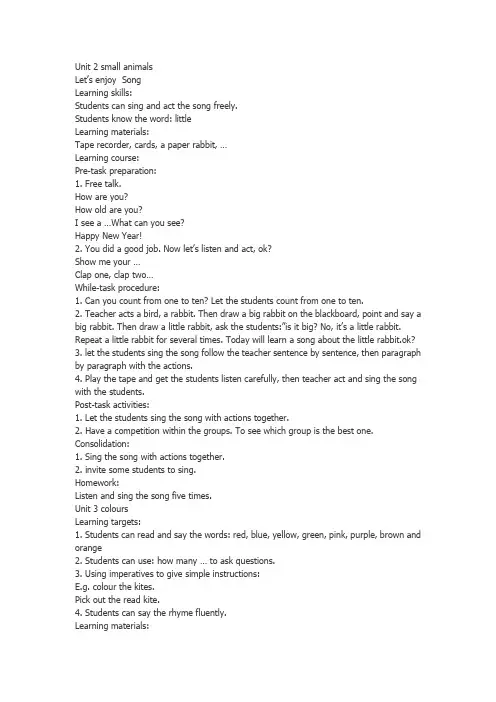
Unit 2 small animalsLet’s enjoy SongLearning skills:Students can sing and act the song freely.Students know the word: littleLearning materials:Tape recorder, cards, a paper rabbit, …Learning course:Pre-task preparation:1. Free talk.How are you?How old are you?I see a …What can you see?Happy New Year!2. You did a good job. Now let’s listen and act, ok?Show me your …Clap one, clap two…While-task procedure:1. Can you count from one to ten? Let the students count from one to ten.2. Teacher acts a bird, a rabbit. Then draw a big rabbit on the blackboard, point and say a big rabbit. Then draw a little rabbit, ask the students:”is it big? No, it’s a little rabbit. Repeat a little rabbit for several times. Today will learn a song about the little rabbit.ok?3. let the students sing the song follow the teacher sentence by sentence, then paragraph by paragraph with the actions.4. Play the tape and get the students listen carefully, then teacher act and sing the song with the students.Post-task activities:1. Let the students sing the song with actions together.2. Have a competition within the groups. To see which group is the best one. Consolidation:1. Sing the song with actions together.2. invite some students to sing.Homework:Listen and sing the song five times.Unit 3 coloursLearning targets:1. Students can read and say the words: red, blue, yellow, green, pink, purple, brown and orange2. Students can use: how many … to ask questions.3. Using imperatives to give simple instructions:E.g. colour the kites.Pick out the read kite.4. Students can say the rhyme fluently.Learning materials:Tape recorder, pictures, wall chart…Lesson 1 3.24Learning skills:1. students can use imperatives to give simple instructions:make eight kites.Colour the kites.Pick out the red kite.Learning materials:Some colour pencils, paper, cards, tape recorderLearning course:Pre-task preparation:1. Free talkHow are you?I see a … what do you see?2. Let’s sing, ok? Let’s sing the little rabbit.While-task procedure:1. it’s spring now, do you like flying kites. Today, let’s make a kite, ok? Let the students read the phrase: make a kite several times. Invite some students to read.2. Now, first please take out your paper, and draw a kite. Then ask the students what should we do now?Yes, we must colour the kites. Get the students read “colour the kites” several times. Invite some students to read.3. Teacher collects some kites, then ask the students: what colour is it?Let the students pick out the red kite.Post-task activities:1.let the students read follow the tape, sentence by sentence. Then read follow the teacher.2.have a competition.To see which group reads best.Consolidation:Invite some students to read.Homework:Listen and read this page five times.Lesson 2 3.28Learning skills:Students can use adjectives to identify and pronounce the colours: red, blue…Learning materials:Some colours, tape recorder, …Learning course:Pre-task preparation:1. Free talkI see a …what do you see?How are you?2. Invite some students to read the sentences on page 12. read these sentences together. While-task procedure:1. Show a red apple. Look, I have an apple, what colour is it? It’s red.2. Show more colours, ask the students what colour are they, if they don’t know, say it without sound, let the students look at the teacher’s mouth to identify the word’s pronounce.2.put the pictures on the blackboard, let the students read follow the teacher, the read together.3. Have a competition.A, Invite one student each group, then to see who is the best reader.B, have a competition within the groups, then to see which group is the best.Post-task activities:1. Play the tape, let the students listen carefully.2. Let the students read follow the tape.3. play games with the students. Cover a colour, get the students guess what it it. Consolidation:Read together.Homework:Listen and read these words five times.Lesson 3 3.29Learning skills:1. Students can ask yes/no questions to obtain a simple response.e.g: is it blue?2. Asking wh-questions to obtain a simple response:e.g: how many kites?Learning materials:Some pictures, tape recorder…Learning course:Pre-task preparation:1. Free talkHow are you?I see a … what do you see?2. Take out your colour pencil. Show me “red, blue, green, …”While-task procedure:1. Show the sentences on page12. let the students read together.2. Show the colour, get the students read together.3. Invite some students to read.4. Look, I have some apples here; can you count how many they are? Let’s count: one, two, three, four,...so how many they are?5. Show some pictures of fruit, practice the sentences: how many …?Teacher ask students: how many … let the students answer the questions.Then invite some students to ask the question, another student answer.6.listen to me, please. What colour is the apple? It is red. Is it blue? No.ask some students to answer: is it blue? Invite some students read this sentence.Post-task activities:1. Open the English book, let the students look at the picture carefully, listen to the teacher to explain the picture.2. Play the tape, let the students listen and repeat follow the tape. Read follow the teacher. Read by themselves.3. let the students read together. Invite some students to read.Consolidation:Have a competition:Divide the class into four groups, let the students read group by group, to see which group is the best one.Homework:Listen and read this page five times.Lesson 4 3.31Learning skills:1.students can ask wh-questions to find out the colours of objectse.g: what colour is it?ing adjectives to identify colours:e.g: it is red.Learning materials:Tape recorder, some objects, cards…Learning course:Pre-task preparation:1. Free talkI see …what do you see?How many …?Show some colours, ask the students: is it …?2. Let the students read the colour words, invite some students to read.While-task procedure:1. Look, I have got something here, can you guess what they are?Let the students guess, then show them to the class. Put them on the blackboard. Teacher points to the pictures nor in the order, invite some students to answer.2.what colour is the …? Let the students say together. Then ask some students to answer what colour are they.3.let the students read the sentence: what colour is it? Several times.Post-task activities:1. Play tick-tack-toe with the students, let the students draw the pictures on the paper.2. Techer say the words, if students can make a line, then say tick-tack-toe, he/she is win. Consolidation:1. Read the page follow the teacher.2. Read group by group, to see which group is the best one.3.read together.Homework:Listen and read this page five time at least.Lesson 5 4.4Learning skills:Students can say the rhyme fluently.Students can identify the colours: blue, brown…Learning materials:Tape recorder, colour papers…Learning course:Pre-task preparation:1. Free talkShow a picture, ask students the question: how many …invite some students to read.I have got a …what have you got?2. Read the sentences on page 15, to check the homework.While-task procedure:1. let the students say the rhyme: one two three it’s a tree, four five six, pick up sticks together.2. Today, we will learn another rhyme. Let the students look at the pictures, listen to me, ok?One, two,Red and blueUp and downOrange and brown,Kites in the sky,Flying very high.3. Now, let’s learn the rhyme, ok?One, two,Red and blueUp and downOrange and brown,Kites in the sky,Flying very high.3. Now, let’s learn the rhyme, ok?Let the students read the rhyme sentence by sentence several times. Then play the tape and get the students read follow the tape.Post-task activities:1. Have a competitionDivide the class into four groups, and let the students read group by group, to see which group is the best one.2. read the rhyme together.Consolidation:Read this unit together, and invite some students to read.Homework:Listen and read this page at least five times.Lesson 6 4.5Review unit 3 & do the workbook.Step 11. Free talk:I see …what do you see?How many …?What colour is it?3. Review the words.Have a competition to see which group can read the best.Step 2. Review the sentences.Show the sentences and then let the students read it. Invite some students to read. Step 3. do workbook.Step 4 homeworkListen and read this unit for three times.Unit 4 postman and policemanLanguage targets:1. Students can use imperative to give simple instructions:Follow me.Turn right.Turn left.2. Using formulaic expressions to identify peoplee.g.: he is a postman.3. Asking yes/no questions to identify people:e.g.: is he a postman?4. Students can read and say the words:Postman, policeman, driver, fireman, milkman, tall, short5. Students can sing the song: he is a postman.4. 7Lesson 1Learning skills:1. Students can use imperative to give simple instructions:Follow me.Turn right.Turn left.Learning materials:Tape recorder, cards, …Learning course:Pre-task preparation:1. Free talkI have got a book, what have you got?I see a … what do you see?What colour …?How many …?2. Sing a song.One little two littleThree little rabbitsFour little five littleSix little rabbits…While-task procedure:1. Show the letter “A”, do you know how to read it? Follow me, A. then show “b”, ask the students follow the teacher to read to teach the new phrase: follow me.2. Let the students read together. Then invite some students to read this sentence.3. Show a puppet, then say: turn right, turn left to it. Do several times and let the students know the meaning.4. Then let the students do together with the teacher. Then ask the students to follow you to read.5. Invite some students to read these two sentences.6. Read these three sentences together.Post-task activities:1. Play the tape and get the students to read the sentences on page17.2. Read follows the teacher.3. Invite some students to read.Consolidation:1. Have a competition to see which group is the best reader.2. Play high voice and low voice.3. Play somin says.Homework:Listen and repeat this page at least five times.4.11Lesson 2Learning skills:1. Using nouns to identify people’s occupationse.g.: postman, policemanLearning materials:Tape recorder, cards….Learning course:Pre-task preparation:1. Free talkI have got a book, what have you got?I see a … what do you see?What colour …?How many …?2. Play simon says.Turn left, turn right…While-task procedure:1. miss shen is a teacher. Look at this picture; do you know who is it? To teach the newwords.2. Put the words on the blackboard; read the words get the student read follow the teacher.3. Play a game: magic eyes & what’s missing.Post-task activities:1. Play the tape, let the students read follow the tape.2. Read follows the teacher.3. Invite some students to read.Consolidation:1. Have a competition to see which group is the best reader.2. Have a competition to see who the best reader is.Homework:Listen and read this page at least five times.4.12Lesson 3Learning skills:1. Using formulaic expressions to identify people:e.g.: he is a postman.2. Asking yes/no questions to identify people:e.g.: Is he a postman?Learning materials:Tape recorder, cards …Learning course:Pre-task preparation:1. Free talkI have got a book, what have you got?I see a … what do you see?What colour …?How many …?2. Review the phrase on page 17, and review the words on page 19.3. Invite some students to read.While-task activities:1. Show a card, ask the students: is he a …? Enco urage students answer: yes or no.S: yes, he is a …S: no. then the teacher ask who is he? He is a …2. Show a card: is he a … he is a … let the students read follow the teacher to read.3. Invite some students to read, correct the pronunciation.Post-task activities:1. Play the tape, let the students read follow the tape.2. add some sentences: he is a driver.He is a fireman.He is a postman.……3.let the students read in order, read together.4.invite some student to read.Consolidation:Invite some students come to the blackboard, and hide a card, let the other students guess. Homework:Listen and read this page at least five times.4.14 Lesson 4Learning skills:1. Using formulaic expressions to identify people:e.g.: he is a postman.2. Asking yes/no questions to identify peoplee.g.: is he a driver?Learning materials:Tape recorder, cards…Learning course:Pre-task preparation:1.put a toy gun, a big bag of letters, a box of milk, a paper steering-wheel and a toyfire-engine on the table. Put the word cards for “policeman”, “postman”, “driver”, “milkman”, “fireman”, “tall ”, and “short”, into abox that has an opening on the top .Have students take turns in drawing out a word card. Tell them to take the appropriate object or do an action so that others can guess what that word is.2. Put up the word cards on the board. Across from them put the corresponding picture cards but in a different order . let students come up to match them.While-task procedure1. Choose five boys to come to the front. Each is given a representative object for the five kinds of people who help us.2. Play the music while passing around the class five cards with sentences written on them,e.g. He is a postman. When the music stops, the students who happen to have the five cards in their hands need to walk out, find the right boys in the front and stand beside them.3. When every boy in the front has been identified, get the rest of the class to point to each of them and say’ he is a’4. Play the matching game until most of the students have the chance to match a sentence with the person it describes.5. Open the Student’s Book to page 20. Play the cassette tape. Students listen and point to each person when the sentence describing him is being read out.Post-task activityShow some photos of the five kinds of people who help us. Have the students ask and answer questions about them in pairs, e.g.S1:Is he a driver?S2:Yes. Is he a postman?S1:No.ConsolidationWorkbook page 15: Tick the correct sentence.4.18 Lesson 5Learning skills:1. Students can use formulaic expressions to identify people:e.g.: he is a policeman.2. Using adjectives to describe people:He is tall.3. Using formulaic expressions to take leave:Goodbye.Learning materials:Tape recorder, cards…Learning course:Pre-task preparation:1. Free talkIs he a postman?How many..?What colour is it?2. Review the words and sentences on page 20.A, show the words, let the students read one by one.B, show the sentences. Let the students read one by one.While-task procedure:1. Show a card, ask the students: is he a postman? Encourage students answer: yes, he isa postman./ no, he is a …2. Point to a student and ask students: is he tall/ short? Encourage students answer: he is tall. He is short.3. Today, let’s learn a song, ok?4. Turn to page 21. Let students read by themselves. Then read follow the teacher. Sentence by sentence, then read paragraph by paragraph.5. Let the students read together.6. Play the tape; let the students listen to the tape together.Teacher sings the song first, then let the students sing the song sentence by sentence follow the teacher. Follow the teacher, sing the song together.Post-task activities:1. Sing the song in role. Boys and girls, to see which role is better. Then girls first, sing the song.2. Sing the song together.3. Clap and sing.Consolidation:1. invite some students to sing the song.Homework:Listen and sing the song at least five times.4.19 lesson 6do workbook and analisys.Unit 5 doctor and nurseLearning targets:1. Using imperatives to give simple instructions:e.g.: listen to me.2. Using formulaic expressions to identify people:e.g.: she is a …3. Ask yes/no questions to identify people:e.g.: is she a …?4. Using nouns to identify people:e.g.: doctor, young, nurse, cook, old.5. Using imperatives to give simple instructions:e.g.: look at the doctor.6. Using adjectives to describe people:e.g.: all very old.4.25 Lesson 1Learning skills:1. Using imperatives to give simple instructions:e.g.: listen to me.Learning materials:Cards, tape recorder, …Learning course:Pre-task-preparation:1. Free talkIs he a …?How many …?2. Play a game: Simon says.Review the action s: open your book, close your book, face, mouth, nose, eye, ear…While-task procedure:1. Show a card: open your mouth, invite some students to read, to see if they can read or not.2. Teacher read it without sound, student imitate the pronunciation and read. Read follow the teacher several times.3. Look at the picture, look at the picture, is she a policeman? Is she a …? She is a doctor. Teach the word, invite some students to read.4. Show a card of a nurse, ask some students: is she a doctor? No, she is a nurse. Teach the title: doctor and nurse, invite some students to read.5. Teacher show a card, read and act: listen to me. Read several times, and invite some students to read.6. When you see a doctor, how she/he say: say “ah”. Invite some students to read. Post-task activities:1. Teacher act the actions, students say the orders. Invite some students to say.2. Play the tape, let the students listen to the tape, try to read follow the tape.3. Read follow the teacher. Then let the students read by themselves.4. invite some students to read the sentences.Homework:Listen and read this page for 5 times.4.26 Lesson 2Learning skills:1. Using nouns to identify peoplee.g.: doctor, nurse, cook…2. Using adjectives to describe people:e.g.: old, yo ung…Learning materials:Tape recorder, cards …Learning course:Pre-task preparation:1. Free talkPoint to the card: is he/she a …?What do you see?2. Review the sentences on page 22.Let the students read together. Then invite some students to read.While-task procedure:1. Show a card, who is he/she? She is a doctor/nurse.2. Show a cook, ask the students: is she a doctor/nurse? No, she is a cook. Invite some students to read, let the students act and cook.3. Put on the wall chart for page 3, point to Sam’s father and say: this is Sam’s father. He is young. Then point to Sam’s grandfather and say: this is tom’s grandfather. He is old. Repeat for students to read.4. Teacher act old and young, let the students say as quick as they can. Hold up the picture cards for “old” and “young”. Say the words slowly and clearly for the students to follow.5. Point to Sam’s mother on the wall chart and ask the students: is she young? To clients “yes”. Then point to Sam’s grandmother and ask: is she young? Encourage s tudents to answer: no, she is old.6. Let the students listen and repeat follow the teacher.7. let the students listen to the tape, and read follow the tape, try to imitate the pronunciation.Post-task activities:1. play magic eyes.2. Invite one student come to the blackboard, and hide one card, let the other students guess who is he/she?3. have a competition. Divide the students into three groups, and then invite one student each group, to see who is the best reader.Consolidation:1.Read these words together.2.invite some students to read.Homework:Listen and repeat this page at least three times.4.28 Lesson 3Learning skills:1. Students can use formulaic expressions to identify people:e.g.: she is a nurse.3. Asking yes/no questions to identify people:e.g.: is she a cook?Learning materials:Tape recorder, cards, …Learning course:Pre-task preparation:1. free talkWhat colour is it? Is it blue?How many …?Is he a …?2. Review the words.Let the students read together. Then invite some students to read, then read these words one by one.While-task procedure:1. Show a card, review the structure: is he a …?2. Show a card, say slowly to the students: is she a …?3. Invite some students to say the difference of him/her. He is standing for a man or a boy, she is standing for a women or a girl.4. Show a cook card, ask the students: is she a nurse?5. show a nurse card, ask students: is she a cook? Encourage students to answer: no, she is a nurse.6. Ask students to open their English book, listen to the tape carefully.7. Read follow the tape, then read follow the teacher. Read by themselves, if you can’t read the sentences, ask the teacher.8. Read this page together. Then invite some students to read.Post-task activities:1. Teacher show a car d, ask the students: is he/she a … let the other students to answer.2. invite a student come to the blackboard, ask other students: is he/she a …? Consolidation:1. Have a competition. To see which group is the best reader.2. read this page together.Homework:Listen and read this page at least five times.4.29 Lesson 4Learning skills:1. Asking “yes/no” questions to identify people:e.g.: is she a doctor?2. using adjectives to describe people”e.g: she is young.ing imperatives to give instructions:e.g: open your mouth.4. using formulaic expressions to express thanks.e.g: thank you, doctor.Learning materials:Tape, cards, …Learning course:Pre-task preparation:1. Free talkIs he/she a …?What colour is it?2. Review the words.A, let the students read these words together.B, have a competition to read the words.While-task procedure:1. Show a picture of a young doctor, ask the students: is she a doctor?Is she old or young? Encourage students to answer: she is young.2. Teacher acts a doc tor, come to a student, let the student: open your mouth, say “ah”. The teacher says: you are fine. Repeat several times. Let the students read together. Invite some students to read.3. Let the students respond the teacher: thank you, doctor.4. Let the students open their English book, turn to page 25. Listen to the tape, listen and repeat follow the tape.5. Let the students read follow the teacher, read by themselves. Read together.Post-task activities:1. Have a competition.Teacher hold six phrase cards, invite one student each group to have a competition, to see which group is the best one.2. Read together. Invite some students to read.Consolidation:Ask students act and say. One act one say, then change the roles.Homework:Listen and repeat at least five times.4.30 Lesson 5Learning skills:1. Using imperatives to give simple instructionsE.g.: look at the doctor.2. Using adjectives to describe people:e.g: all very old.Learning materials:Tape recorder, cards…Learning course:Pre-task preparation:1. Free talkIs she/he a …Is she/he young/old?2. review the words.Let the students read together, invite some students to read, then have a competition to read these words.While-task procedure:1. Stick the cards on the blackboard: doctor, nurse, cook, book. Point to each picture and say “she is a doctor. She is a nurse. She is a cook. This is a book.”2. Let the students look at the doctor, she is old. What is she doing? She is reading a book. The book is about a nurse and a cook. Today we will learn a rhyme about the old doctor.3. Let the students look at these pictures and teach the phrases: look at, read a book, about, a nurse and a cook, all very old.4. Let the students read these words together, then invite some students to read.5. Teacher put these words on the blackboard, and then let the students follow the teacher to read.6. play the tape, let the students listen to the tape and read follow the tape.7. play the tape again, students follow and say the rhyme in lines. Encourage the students to say the rhyme with you with actions.Post-task activities:1. invite some students to act out the rhyme. Students vote for the best performer.2. divide the class into groups, have each group act out the rhyme to the class. The best group will be the winner.Consolidation:Read this rhyme together.Homework:Listen and read this rhyme at least five times.5.8 Lesson 6Step1:Do workbook of unit 5Step 2:Analysis the workbook.Homework:Read this unit three times.。
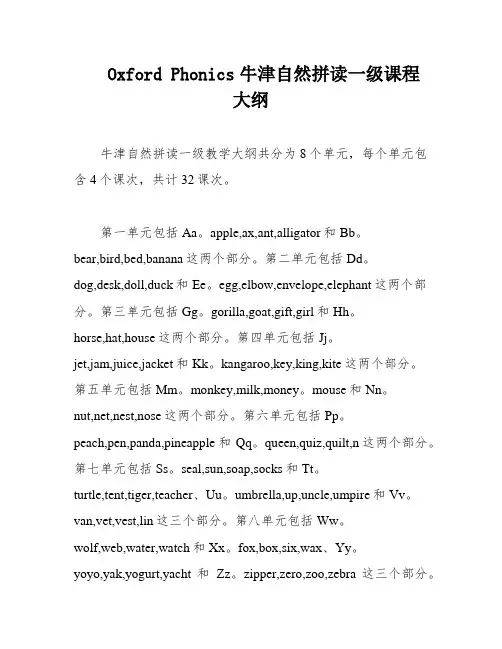
Oxford Phonics牛津自然拼读一级课程大纲牛津自然拼读一级教学大纲共分为8个单元,每个单元包含4个课次,共计32课次。
第一单元包括Aa。
apple,ax,ant,alligator和Bb。
bear,bird,bed,banana这两个部分。
第二单元包括Dd。
dog,desk,doll,duck和Ee。
egg,elbow,envelope,elephant这两个部分。
第三单元包括Gg。
gorilla,goat,gift,girl和Hh。
horse,hat,house这两个部分。
第四单元包括Jj。
jet,jam,juice,jacket和Kk。
kangaroo,key,king,kite这两个部分。
第五单元包括Mm。
monkey,milk,money。
mouse和Nn。
nut,net,nest,nose这两个部分。
第六单元包括Pp。
peach,pen,panda,pineapple和Qq。
queen,quiz,quilt,n这两个部分。
第七单元包括Ss。
seal,sun,soap,socks和Tt。
turtle,tent,tiger,teacher、Uu。
umbrella,up,uncle,umpire和Vv。
van,vet,vest,lin这三个部分。
第八单元包括Ww。
wolf,web,water,watch和Xx。
fox,box,six,wax、Yy。
yoyo,yak,yogurt,yacht和Zz。
zipper,zero,zoo,zebra这三个部分。
每个单元都包括两个部分,每个部分包括四个单词。
在每个单元的第三和第六课时,会对前两个部分进行复。
在第八课时,会对前四个部分进行复。
在第四、六和八课时,会进行模块测验,检查学生对该模块的掌握情况。
最后,第19课时是期末总复,对所有单元的内容进行复。
课程简介:Oxford Phonics World是一门英语单词研究课程,其中80%以上的单词都符合一定的发音规则。
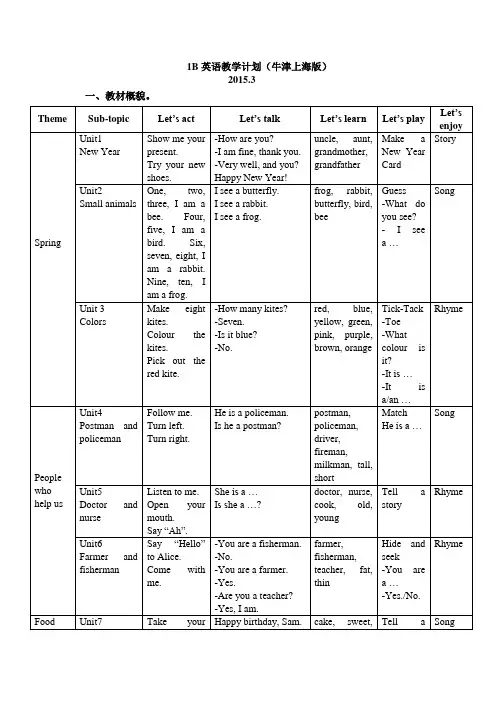
1B英语教学计划(牛津上海版)2015.3一、教材概貌。
Theme Sub-topic Let’s act Let’s talk Let’s learn Let’s play Let’s enjoySpring Unit1New YearShow me yourpresent.Try your newshoes.-How are you?-I am fine, thank you.-Very well, and you?Happy New Year!uncle, aunt,grandmother,grandfatherMake aNew YearCardStoryUnit2Small animalsOne, two,three, I am abee. Four,five, I am abird. Six,seven, eight, Iam a rabbit.Nine, ten, Iam a frog.I see a butterfly.I see a rabbit.I see a frog.frog, rabbit,butterfly, bird,beeGuess-What doyou see?- I seea …SongUnit 3ColorsMake eightkites.Colour thekites.Pick out thered kite.-How many kites?-Seven.-Is it blue?-No.red, blue,yellow, green,pink, purple,brown, orangeTick-Tack-Toe-Whatcolour isit?-It is …-It isa/an …RhymePeople who help us Unit4Postman andpolicemanFollow me.Turn left.Turn right.He is a policeman.Is he a postman?postman,policeman,driver,fireman,milkman, tall,shortMatchHe is a …SongUnit5Doctor andnurseListen to me.Open yourmouth.Say “Ah”.She is a …Is she a …?doctor, nurse,cook, old,youngTell astoryRhymeUnit6Farmer andfishermanSay “Hello”to Alice.Come withme.-You are a fisherman.-No.-You are a farmer.-Yes.-Are you a teacher?-Yes, I am.farmer,fisherman,teacher, fat,thinHide andseek-You area …-Yes./No.RhymeFood Unit7 Take your Happy birthday, Sam. cake, sweet, Tell a Songand drinkBirthday party present.Open yourpresent.Say “Thankyou”.ice-cream,jelly, milk,CokestoryUnit8DinnerDrink somejuice.Eat somemeat.-Do you like fish?-Yes, I like fish.-Do you like chicken?-No, I don’t likechicken.meat, fish,chicken, rice,noodles, soupHavedinner-Do youlike …?-Yes, Ilike …-No, Idon’tlike …Tongue-twisterUnit9Revision二、教材特点。
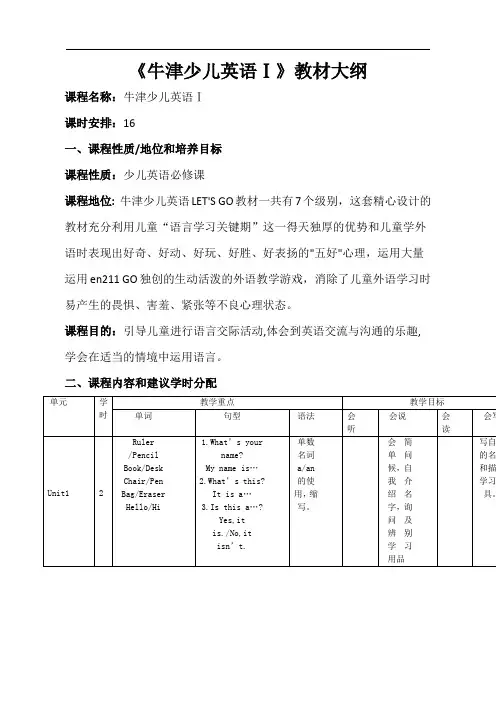
《牛津少儿英语Ⅰ》教材大纲
课程名称:牛津少儿英语Ⅰ
课时安排:16
一、课程性质/地位和培养目标
课程性质:少儿英语必修课
课程地位:牛津少儿英语LET'S GO教材一共有7个级别,这套精心设计的教材充分利用儿童“语言学习关键期”这一得天独厚的优势和儿童学外语时表现出好奇、好动、好玩、好胜、好表扬的"五好"心理,运用大量运用en211 GO独创的生动活泼的外语教学游戏,消除了儿童外语学习时易产生的畏惧、害羞、紧张等不良心理状态。
课程目的:引导儿童进行语言交际活动,体会到英语交流与沟通的乐趣,学会在适当的情境中运用语言。
二、课程内容和建议学时分配
三、培养目标与教学方法
培养目标:熟练表达简单对话,熟练拼写100个英语单词/掌握58个动词短语;掌握问候/介绍/感谢/询问天气等语言交流项目;常用的
单词到达会听/说/读/写;书中涉及的动词短语/句型达到会听/说/读。
听力达到15个单词/分钟到达国家英语课程9级标准第1级水平。
教学方法:
✧情景交际法
✧全身反应法
✧合作学习法
✧游戏教学法
✧活动教学法
✧功能意念法✧自然拼读法。
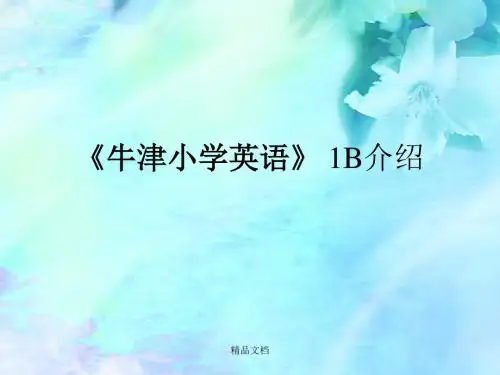
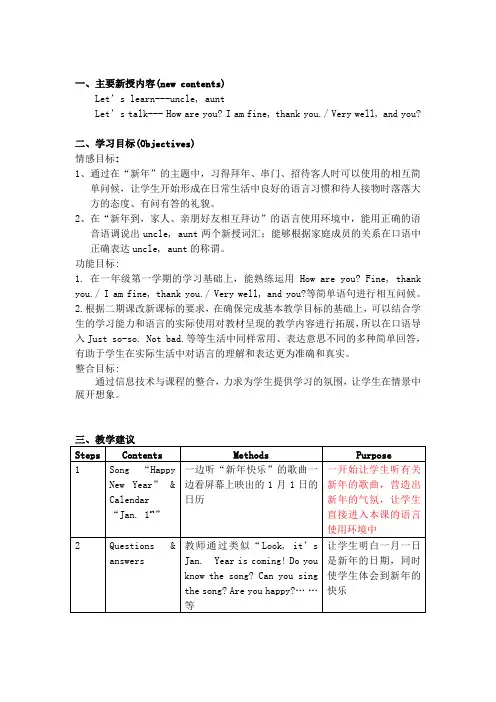
一、主要新授内容(new contents)Let’s learn---uncle, auntLet’s talk--- How are you? I am fine, thank you./ Very well, and you?二、学习目标(Objectives)情感目标:1、通过在“新年”的主题中,习得拜年、串门、招待客人时可以使用的相互简单问候,让学生开始形成在日常生活中良好的语言习惯和待人接物时落落大方的态度、有问有答的礼貌。
2、在“新年到,家人、亲朋好友相互拜访”的语言使用环境中,能用正确的语音语调说出uncle, aunt两个新授词汇;能够根据家庭成员的关系在口语中正确表达uncle, aunt的称谓。
功能目标:1. 在一年级第一学期的学习基础上,能熟练运用How are you? Fine, thank you./ I am fine, thank you./ Very well, and you?等简单语句进行相互问候。
2.根据二期课改新课标的要求,在确保完成基本教学目标的基础上,可以结合学生的学习能力和语言的实际使用对教材呈现的教学内容进行拓展,所以在口语导入Just so-so. Not bad.等等生活中同样常用、表达意思不同的多种简单回答,有助于学生在实际生活中对语言的理解和表达更为准确和真实。
整合目标:通过信息技术与课程的整合,力求为学生提供学习的氛围,让学生在情景中展开想象。
类似导入uncle,但节奏更快、更直接地导入aunt一词,教师不用猜而直接提示:This is father’s sister. 引入aunt把语音和语义同时输入给学生。
aunt的机械性操练也可以先全体跟着教师朗读。
其中开始一两遍可以是正常声音升降调跟读,接着可以由响到轻或由轻到响地跟读。
旨在通过跟读音调的变化既达到反复模仿上口,又减少机械模仿的枯燥。
Unit 1 New Year第二课时(2nd PERIOD)一.要新授内容(new contents)Let’s learn---grandmother, grandfatherLet’s talk----Happy New Year!二.主要目标(Objectives)情感目标:1.通过“新年”这个主题,使学生学会用新年特定的问候语Happy New Year与家人或客人相互问候,让学生在日常生活中养成良好的语言习惯及文明习惯。

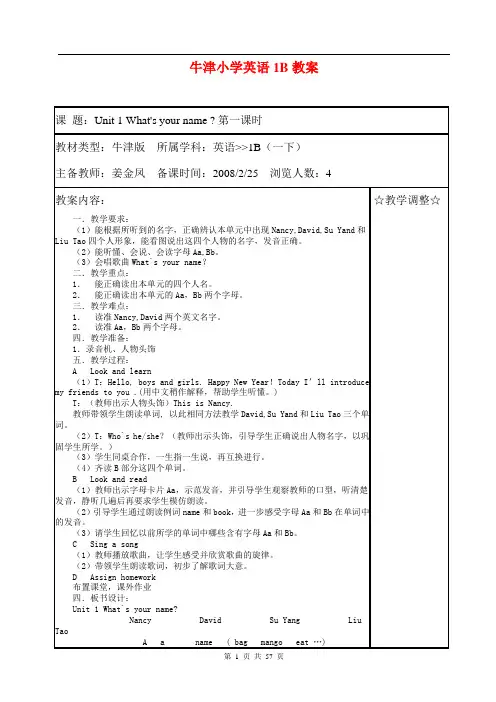
Oxford English 1B M1U1(1)Content Oxford English 1B M1U1 Look and see(1)1. Using nouns to identify small animalsAims e.g. frog, rabbit, bee, bird2. Using numbers to counte.g. one, two three3. Using the key patten to introduce oneselfe.g. I am a⋯Language 1. Using nouns to identify small animalsfocus 2. Using numbers to count3. Using the key patten to introduce oneself Teaching aids Cassette, Wall picture, Several paper cut-outs of animalsProcedure Content ProceduresMethod PurposePre-task 1. Show a park. 1. Show a picture of a park to the preparation students. Ask them what theysee.T: Look, what can you see? Afrog, a bee ⋯2. Guessing. 1. Mime the small animals andlet students guess what theanimals are.T: What am I? (Mimes) Yes, I?ma rabbit.While-task 1. Miming. 1. Ask the students to say and procedure mime the actions of the animals.2. Rhyme. 1. Teach the rhyme on Student?sBook page 2. w W w .X k b 1.c O m3. Say and act. 1. Divide the class into pairs. Askthem to act as an animal and letthe partner guess what animal itis.A: Are you a rabbit?B: Yes, I?m a rabbit. / No, I?mnot a rabbit.4. Guessing game. 1. Use the paper cut-outs. Showthe students some parts of thesmall animals and ask them toguess what the animals are. Thestudents can play this guessinggame in groups.Post-task activityA:What is it?B:It?s a bee.1.Make a mask and a 1. Ask each student to make a dialogue.mask of an animal.2.Ask them to put on their masksand make a dialogue with theirpartner.A: Hello. I am a bee. I am small.B: Hi, I am a frog. I am green. 2. Act the rhyme. 1. Ask the students to say and actthe rhyme on page 2.3. Listen and tick. 1. Ask the students to do Part A?Listen and tick? on Workbookpage 2. Then have them work inpairs to introduce each animal.A: It?s a w ⋯W w .x K b 1.c o MB: It?s a ⋯板4. Act and guess.Unit 1 Look and seeseebeebird1.Have the students do PartB ,Act and guess? on Workbookpage 3 and then ask them to doan activity like this in groups.复上学期英字母,是本学期开始的关教。
上海版牛津1B 全册教案Module 1 Using my five senses Unit 1 Look and seeUnit 2 Listen and hearUnit 3 Taste and smellModule 2 My favourite things Unit 1 Toys I likeUnit 2 Food I likeUnit 3 Drinks I likeModule 3 Things around us Unit 1 SeasonsUnit 2 WeatherUnit 3 ClothesModule 4 Things we doUnit 1 ActivitiesUnit 2 New Year's DayUnit 3 Story timeTask in this unit:●Begin an interaction by expressing one’s preferences●Begin an interaction by eliciting a responseLanguage focus:●Using nouns to identify toys: ball,doll,bicycle,kite●Using adjectivesto describe things: It’s super.●Using the definite article to indicate particular things: the ball,the doll●Using formulaic expressions to offer people help: Can I help you?●Using formulaic expressions to offer people things: Here you are.●Using formulaic expressions to express thanks: Thank you.Language skills:Listening:●Identify the key words in an utterance by hearing the pronunciation:ball,doll,bicycle,kite●Understand the key pattern: I like…●Understand formulaic expressions to offer people things: Here you are.●Understand formulaic expressions to offer people help: Can I help you? Speaking:●Pronounce the words,phrases and sentences correctly: ball,doll,bicycle,kite●Use formulaic expressions to indicate preferences: I like…●Use formulaic expressions to offer people things: Here you are.●Use formulaic expressions to express thanks: Thank you.●Use adjectivesto describe things: It’s super.●Use formulaic expressions to offer people help: Can I help you?Module2 / Unit 1 / Period 1Aims:1. Words: ball,doll,bicycle,kite2.Function: Use formulaic expressions to indicate preferences: I like…Language focus:1. Pronounce the words,phrases and sentences correctly2. Understand the key pattern: I like…Aids: Pictures, Realia, tape.Module 2 / Unit 1 /Period 2Aims:1. Use formulaic expressions to offer people things: Here you are.e formulaic expressions to express thanks: Thank you.e adjectivesto describe things: It’s super.e formulaic expressions to offer people help: Can I help you? Language focus:1. Understand formulaic expressions to offer people things: Here you are.2. Understand formulaic expressions to offer people help: Can I help you? Aids: Pictures, Realia, tape.Module 2 / Unit 1 /Period 3Aims:1. Review the words: ball,doll,bicycle,kite2. Review the sentences: I like …3. Drills: I like the ….Language focus:Use formulaic expressions to indicate preferences: I like the…Aids: Pictures, Realia, tape.Module 2 My favourite thingsUnit 2 Food I likeTasks in this unit1.Begin an interaction by introducing one’s preferences2.End an interaction by using simple formulaic expressions3.Begin an interaction by eliciting a responseLanguage focus1. Using nouns to identify foodeg. jelly, ice, cream, sweet, biscuiting formulaic expressions to indicate preferencese.g. I like ice cream.3. Asking yes/no questi ons to find out one’s preferencese.g. Do you like,…?4. Using formulaic expressions to confirm or denye.g. Yes./No.ing formulaic expressions to offer people thingse.g. One for you.Learning skills:Listening5.Identify the key words in an utterance by hearing the pronunciationeg. jelly, ice, cream, sweet, biscuit6.Identify specific information in response to questionse.g. Do you like sweets? No.3. Understand formulaic expressions indicating preferencese.g. I like ice cream.Speaking1.Identify the key words in an utterance by hearing the pronunciationeg. jelly, ice, cream, sweet, biscuit2. Using formulaic expressions to indicate preferencese.g. I like …3. Asking yes/no questions to find out one’s prefe rencese.g. Do you like,…?4. Using formulaic expressions to confirm or denye.g. Yes./No.5. Using formulaic expressions to offer people thingse.g. One for you.The first PeriodAims:1. Words: jelly, ice, cream, sweet, biscuit6.Function: Use formulaic expressions to indicate preferences: I like…Language focus:1. Pronounce the words, phrases and sentences correctlye.g. jelly, ice, cream, sweet, biscuit2.Understand the key pattern: I like…Aids: Pictures, Radio, tape.The second PeriodAims:1.Words: jelly, ice, cream, sweet, biscuit2.Sentences: Do you like …? Yes./No.One for you and one for me.Function:1. Asking yes/no questions to find out one’s preferencese.g. Do you like,…?2. Using formulaic expressions to confirm or denye.g. Yes./No.Language focus:1. Asking yes/no questions to find out one’s preferencese.g. Do you like,…?2. Using formulaic expressions to confirm or denye.g. Yes./No.Aids: Pictures, Radio, tape.The third periodA:Contents :Sentence: One for you and one for you.B:Teaching Aims :Using formulaic expressions to offer people thingse.g. One for you.C:Teaching aids :Recorder and workbook ,picture cardsModule 2 My favourite thingsUnit 3 Drinks I likeTasks in this unit:●Begin an interaction by introducing one’s preferences●End an interaction by using simple formulaic expressions●Begin an interaction by eliciting a responseLanguage focus:●Using nouns to identify drinks: cola,juice,milk,water●Using imperatives to give simple instructions: Drink some milk,Sam.●Using the indefinite determiner some to show quantity: Drink some water,Mum.●Asking wh-questions to ask for specific information about a person: What do youlike?●Using the simple present tense to express preferences: I like water.●Using formulaic expressions to wish someone a happy birthday: HappyBirthday,Eddie.Language skills:Listening:●Identify specific information in simple instructions: Drink some milk,Sam.●Identify the key words by hearing the pronunciation: cola,juice,milk,water●Identify specific information in response to simple questions: What do you like?Ilike water.●Understand formulaic expressions wishing someone a happy birthday: HappyBirthday,Eddie.Speaking:●Pronounce the words,phrases and sentences correctly: cola,juice,milk,water●Using imperatives to give simple instructions: Drink some milk,Sam.●Asking wh-questions to ask for specific information about a person: What do youlike?●Use the key pattern to express preferences: I like water.●Use adj ectivesto describe things: It’s super.●Use formulaic expressions to wish someone a happy birthday: HappyBirthday,Eddie.Drinks I likeThe First PeriodAims:1.Words: cola,juice,milk,water2.Function: Use specific information in response to simple questions: What do you like? Ilike…Language focus:1.Pronounce the words,phrases and sentences correctly2.Identify specific information in response to simple questions: What do you like? Ilike…Aids: Pictures, Realia, tape.Drinks I likeThe Second PeriodAims:e imperatives to give simple instructions: Drink some milk,Sam.2.Ask wh-questions to find out one’s preferences: Wha t do you like?e the key pattern to express preferences: I like water.Language focus:ing imperatives to give simple instructions: Drink some milk,Sam.2.Asking wh-questions to find out one’s preferences: What do you like?ing the verb like to indicate preferences: I like water.Aids: Pictures, Realia, tape.Drinks I likeThe Third PeriodAims:1.Review the words: birthday,cola,juice,milk,water2.Review the sentences: What do you like? I like water(milk, cola,juice).e formulaic expressions to wish someone a happy birthday: Happy Birthday,Eddie. Language focus:Using formulaic expressions to wish someone a happy birthday: HappyBirthday,Eddie.Aids: Pictures, Realia, tape.Module 4 Things we doUnit 2 New Year’s DayTasks in this unit:Begin an interaction and maintain it by responding to questions Using modeled phrases to communicate with other students.Use formulaic expressions to offer people thingsLanguage focus:Using nouns to identify objectse.g., gift, card, firework, firecrackerUsing imperatives to give instructionse.g., Draw. Write. Fold.Using adjectives to describe thingse.g., newUsing formulaic expressions to greet people on New Y ear’s Daye.g., Happy New Year!Using formulaic expressions to offer people thingse.g., A gift for you.Using the simple present tense to express interest and preferencese.g., I like the red dress.Language skills:ListeningIdentify specific information in response to simple instructionse.g., draw, write, foldUnderstand the key patterne.g., I like the red dress.Identify the key words in an utterance by hearing the pronunciation e.g., gift, card, firework, firecrackerunderstand formulaic expression s of New Year’s greetingse.g., Happy New Year!Understand formulaic expressions offering people thingse.g., A gift for you.Understand a simple story with the help of pictures and body language SpeakingPronounce the words, phrases and sentences correctlye.g., gift, card, firework, firecrackerUse imperatives to give instructionse.g., Draw. Write. Fold.Use formulaic expression to greet peoplee.g., Happy New Year, Miss Fang.Use the pattern I like the … to express interests and preferences e.g., I like the sweets.Use formulaic expressions to offer people thingse.g., A gift for you.Use formulaic expressions to express thankse.g., Thank you.Period 1Language focus:Using nouns to identify objectse.g., gift, card, firework, firecrackerUsing formulaic expressions to greet people on New Year’s Day e.g., Happy New Year!Using formulaic expressions to offer people thingse.g., A gift for you.Language skills:ListeningIdentify the key words in an utterance by hearing the pronunciation e.g., gift, firework, card, firecrackerUnderstand formulaic expressions of greetingse.g., Happy New Year!Understand formulaic expressions offering people thingse.g., A gift for you.Understand the meaning of the song.SpeakingPronounce the words, phrases and sentences correctly e.g., firecracker, gift, firework, cardUse formulaic expressions of greetingse.g., Happy New Year!Use formulaic expressions to offer people thingse.g., A gift for you.Use formulaic expressions to express thankse.g., Thank you.Sing the song and act it outMaterials:Student’s Book 1B, pp.42 and 45Workbook 1B, p.42, Part ACassette 1BWall picture 1BFlashcards 1B (gift, card, firework, firecracker)M4 Unit 2 New Year’s D aygift Happy New Year! card Happy New Year! firecracker A gift for you, …. firework Thank you. Exercise:Act out the dialogue with your classmates.。
一年级英语课程纲要刚刚接触英语,因而,对于一年级的学生来说要同时学好英语和中文在一定成都上是有些困难的。
因此,我们要努力培养他们对英语的学习兴趣和学习习惯,使他们热爱英语这门学科,因而学有所得。
本教材共包含了九个单元,其中八个新授单元和一个复习单元,按“话题—功能—结构—任务”相结合的体系设置,安排了大量形式多样、情景真实、语言自然、趣味性强的语言实践活动。
能够很好的促进学生在交流活动中学习英语。
每个单元有5个部分组成:第一部分是Let’s act 情景版块。
该板块通过情景对话着重训练学生的听说技能,提高会话能力。
第二部分是Let’s talk ,主要呈现出本单元的重点问答句。
第三部分是Let’s learn。
主要呈现出本单元的重要单词。
第四部分是Le t’s play 主要是对本单元重点内容的应用。
第五部分由song rhyme story组成增加了学习的应用性和趣味性。
复习板块有计划、有顺序、生动形象的复习了所学的重点单词及语句。
教学目标和教学计划1、能按照三会要求掌握所学单词。
2、能按照五会要求掌握所学句型。
3、能使用日常交际用语,进行简单的交流,做到大胆开口,发音清楚,语调正确,达到学以致用的目的。
4、能在图片、手势、情景等非语言提示的帮助下,听懂清晰的话语和录音。
5、养成听、说、读英语的习惯,认真模仿语音语调,以逐步培养语感。
初步培养良好的书写习惯,能做到书写规范整洁。
6、能演唱已学过的英语歌曲,诵读已学过的歌谣。
7、培养良好的学习习惯和学习兴趣和培养同学间的协作精神和爱国主义精神。
各单元教学计划Unit1.1. 能听的懂,会说、会读、和会拼写单词:book ruler pencil rubber pen bag 2.能听得懂、会说、会读句型:How are you? Fine, thank you. Good morning.3.能唱songUnit 21.能听的懂,会说、会读、和会拼写单词:one two three four five six2.能听得懂、会说、会读句型:Hi, This is ---,Hello, I’m--3. 会Rhyme.Unit 31. 能听的懂,会说、会读、和会拼写单词:dance read jump sing draw write2. 听得懂、会说、会读句型:How old are you? I am five years old.3. 能听懂英语小故事4. 会唱songUnit41. 听得懂、会说、会读和拼写单词eye mouth face nose ear2. 听得懂、会说、会读句型:Look, This is my hand .This is my arm.3. 会唱songUnit 51. 听得懂、会说、会读和拼写单词:apple melon orange peach lemon pearbanana2. 听得懂、会说、会读句型: This an apple. This is a pear . What’s is----- Isthat -----?Smell the peach3. 领会小故事Unit61. 听得懂、会说、会读和拼写单词:taro moon bean leaf moon cake autumn2. 听得懂、会说、会读句型:I like to eat---3. 能用I have got---来表达自己拥有的东西。
上海牛津版小学英语一年级下(1B)教案通过整理的上海牛津版小学英语一年级下(1B)教案相关文档,希望对大家有所帮助,谢谢观看!Module 1Using my five senses Unit 1 教学内容: Look and say What do you see? I see… Look and learnfrog/rabbit/bee/bird Ask and answer What do you see? I see… What colour is it? It’s… Play a game What do you see? Liste n and enjoy A rhyme教时安排: 1st period Look and learnListen and enjoy 2nd period Look and sayPlay a gameAsk and answer教学内容: 认知内容:能听懂会说frog/rabbit/bee/bird,掌握句型:What do you see? I see…能力要求:会向他人询问所看见的东西,能在生活中运用学到的英语。
情感态度:培养学生喜欢、爱护小动物的思想情感。
the first period 教学过程: Procedures Contents Methods PurposePre-task preparation Revision 1.Great each other: T: Good morning, boys andgirls. S: Good morning, teacher. 2.sing the song : Good morning 通过师生互相问候,巩固问候语句型。
通过英语歌曲,激发学生的学习兴趣。
hile-task procedurepost-taskactivityAssignment Review the words:panda/bear/tigerl/monkey 1. Presentation 2. PracticeLearn the new words frog/rabbit/bee/birdGameA rhyme : PresentationReview the rhyme Let the students play a guessing game. T: It’s fat.It’s black and white.what is it? 1. Say after the teacher 2. Say together 3. ask and answer in pairs. 4. say and act in pairs. T:We have many new friends, let’s see what are they? 1. Read after the teacher 2. read it one by one. 3. read it in high voice in low voice. 4. Who can be little teacher?Play a guessing game. Hold the word cards on the teacher’s hand. The students can’t see the words. Then get them guess. If he is right,he can get a gift.One,two,three, I am a bee. Four,five, I am a bird. Six,seven,eight, I am a rabbit Nine,ten, I am a frog. Ask the students to say after the teacher.1. ask the students to say and act it in pairs.2. ask some students to say and act in front of the class.Listen to the type Read the new words Recite the new rhyme. 通过做“猜一猜”的游戏,使得学生复习上学期所学的有关动物的单词。
Module 1 Using my five sensesUnit 1认知内容: 能听懂会说frog/rabbit/bee/bird,掌握句型:What do you see? I see…能力要求:会向他人询问所看见的东西,能在生活中运用学到的英语。
情感态度:培养学生喜欢、爱护小动物的思想情感。
the first periododule1Unit 2ListenandhearI.知识点●Dailyexpressions:Whatdoyouhear?hear…Whatcanyouhear?Icanhear…●Text types: song, game, conversation, storyII. 课时安排●Period 1: a. Look and learn: sheep hen dog catListen and say: What do you hear?I hear…b. Play a game●Period 2: a. Look and say: What do you hear? I hear…What can you hear? I can hear…b. Say and act : a short dialogue ‘At home’c. Make a short dialogue.d. sing a song “Bingo”III. The contentsWords: sheep hen dog catSkills: What do you hear? I hear…IV. 能力要求学生学会用句型What do you hear?进行讯问。
会用I hear..来回答V. 情感态度学生在游戏和表演中学习新的知识, 并通过游戏和表演来巩固新知识,创设良好的活动氛围, 让学生带着愉快的心情去迎接新的挑战.Module1 Using my five sensesUnit 3 Taste and smell教学内容:教学内容:认知内容:1. 能听懂并会说rice,soup,egg,noodles2.能够用祈使句来请别人闻一闻,尝一尝能力要求:能够在食物方面表达自己的喜好情感态度:培养学生在生活中运用英语的能力教学过程:secondperiod教学内容:认知内容:1. 熟练使用祈使句:standup,touchyournose.Smelltheflower.2. 能认读listenandenjoy能力要求:能够背诵儿歌,并能熟练运用祈使句情感态度:能用How many..?的句型问答身边事物的数量教学过程:Module 1 Unit 3 Taste and smell (一)教学目标(二)划分课时Homework: 1. read SB P10, 13.2. Tell your parents which foods or fruits smell nice, or taste yummy.第二课时(2nd PERIOD)Homework: 1. read SB P11,12.2. students practice the dialogue in groups after class.Module 2 My favourite thingsUnit 1 Toys I like教学内容:认知内容: 能听懂会说ball/doll/bicycle/kite; 掌握句型I like the …/What do you like? I like…能力要求:会用英语与他人交流彼此的喜好情感态度:玩具是孩子们的好朋友, 注意引导孩子爱护玩具,懂得与朋友分享secondperiod教学内容:认知内容:1.能听懂会说super/nice等形容词2. 正确理解I like the…和I like my …句型3. 掌握What do you like? I like …句型能力要求: 1. 会用简单的英语与营业员交流2. 会表达自己的喜好并简单说明原因情感态度:鼓励孩子用英语在公共场合与他人进行交流, 如商店等。
牛津英语1B课程纲要安晓鸽
牛津英语1b课程纲要
郑东新区昆丽河小学安晓鸽
一、课程目标
本册教科书共九个单元,每个新授单元都围绕一个话题,结合功能和结构,安排了一系列语言实践活动,这样设计和安排的目的,是让学生通过体验、实践、参与、合作、交流和探索等方式。
学习语言知识,语言技能及学习技巧完成学习任务,同时使教学过程成为师生之间学生之间相互交流、相互沟通、相互理解、相互补充的互动过程。
具体目标如下:
1、能比较熟练地运用所学的日常交际用语,进行简单交流,并做到大胆开口,发音正确,所用话语与场面相符。
2、能根据实物、图片说出所学单词,发音基本正确。
3、能在非语言提示(如图片、手势等)的帮助下,听懂清晰的话语和录音。
4、能演唱已学过的英语歌曲,诵读已学过的歌谣。
5、养成良好的听英语、读英语、说英语的习惯,能自觉地模仿语音、语调,逐步培养语感。
二、课程内容及安排
本册教材共有九个单元,每个单元各有五个板块组成。
各个板块既相对独立、有所侧重,又紧密联系、相互呼应。
教师要根据教学的具体情况,巧妙利用各个板块的特点,将各个板块有机组合、相互渗透。
第一部分Let's act,学习用祈使句发布命令,并且听到命令能准确地做出相应的动作。
结合一定的情景着重训练学生的听说、表演及快速反应能力。
第二部分Let's talk是情景对话板块。
该板块通过情景对话,着重训练学生的听说技能,提高会话能力,同时呈现新的词汇、功能项目和句型。
第三部分Let's learn,主要按话题归类和图词结合的方式呈现词汇,均为一些简单常见并且易于学生掌握的单词。
,通过游戏、调查等活动进一步巩固所学内容。
s play'Let第四个板块是
牛津英语1B课程纲要安晓鸽
第五个板块是Let's enjoy,通过歌曲、歌谣、绕口令活动来增加学生学习英语的趣味性。
最后一部分,是练习手册,它对教材有很好的辅助性作用,集趣味性,实用性和灵活性于一体。
具体安排:
2.12.21预备常规教
2.22.28Unit 1课
3. 3.7Unit 1课
3.13.14Unit 2课
3.13.21Unit2课
3.23.28Unit 2课
3.3
4.4Unit 3课
4.4.11Unit 3课
4.14.18Unit 4课
第10周4.21—4.25 Unit 4 2课时
课时2Unit 5 4.30 —4.28 周11第
牛津英语1B课程纲要安晓鸽
三、课程实施1、以学生发展为宗旨,以培养学生的创新精神和实践能力为重点,面向全体学生,始终把激发学生的学习兴趣放在首位。
2、一年级的学生学习英语的兴趣浓厚,乐于模仿,但控制力差,有意注意的时间短。
在课堂教学中,利用各种媒体、游戏、歌谣等,进行大量的语言操练和练习,让学生将所学知识转化为语言技能,培养初步的语感和用英语进行简单日常交流的能力。
、课堂教学以情景为依托,更加生活化。
以活动为主线,使英语教学交际化。
3.
安晓鸽牛津英语1B课程纲要、教学方法灵活多样化。
教师要设计多种游戏方式,让学生在学中玩、玩中学,使英语学习4充满童趣、情趣、乐趣,最终让学生对英语产生兴趣。
充分考虑到小学生好动爱玩的特点,以活动为课堂教学的主要形式,设计丰富多彩的教学活动,让学生在乐中学、学中用,并且保证学生英语学习的可持续性发展。
、一年级学习英语的起始阶段,要注重对学习习惯的培养,在学习的过程中逐渐要求学生做5而忽视纠错,不能及于求成,模仿。
老师也要对好的学习习惯进行评价,注重教的过程,到:静听,并且要注意课堂教学用语的使用,
使学生真正能感受到在一种英语学习的氛围之中。
四、课程评价引导学评价的目的是激发学生的学习兴趣,教学评价是一年级英语课程的一个重要组成部分,生积极学习。
对学生学习效果的评价应当注重形成性评价,评价内容应包括听力能力、口语会话、认读能力、学习行为和学习习惯等。
评价形式应多样化,包括教师评价,学生自我评价,家长参与而采取记录平评价等。
包括期末和学年评价在内的一年级英语学习评价均不采取书面考试的方式,时活动和完成任务的表现等方式。
评价内容及方法:(一)听(根据录音内容选择正确答案):10%
根据学习内容随机选题。
评价标准:
都能选对为“优”
选对3-4个为“良”
选对2个以下单词为“合格”
(二)说(与老师进行日常对话)10%
评价标准:
声音洪亮、发音标准、仪表大方、语言流利为“优”
安晓鸽牛津英语1B课程纲要比较大方、发音比较准确、流利的得“良”
能够回答老师的提问、声音小,表达不流利的得“合格”
(三)认读能力(根据所给图片或中文选择正确单词五个词)10%
评价标准:
都能认读出来为“优”
认读3-4个为“良”
认读2个以下单词为“合格”
(四)学习态度10%
评价标准:
课上认真听讲,积极举手回答问题,声音洪亮,乐于与同学和老师进行交流的,为“优”
能认真听讲,但不爱发言或发言时声音不响亮的,为“良”
基本能认真听讲,但时有走神情况的,为“及格”
附:评价表
听口认学综单总内容评合读语力习元评成态能会能结
果价力话力度绩方(40%)
(20%)
(10%)
(10%)
(10%)
(10%)
式
牛津英语1B课程纲要安晓鸽学
自评家评教
评价。